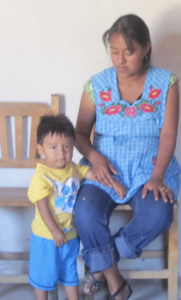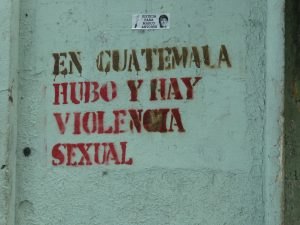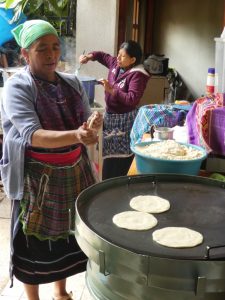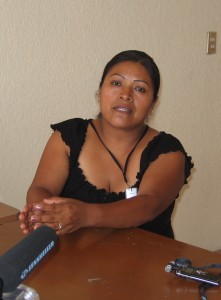
Dr. Lynn Stephen is Distinguished Professor of Arts and Sciences, Professor of Anthropology, and Director of the Center for Latino/a and Latin American Studies (CLLAS) at the University of Oregon. Stephen is a cultural anthropologist whose interdisciplinary research has been at the forefront of illuminating major challenges facing Mesoamerican indigenous peoples–out-migration, tourism, state assimilation programs and nationalism, economic development, violence and low-intensity war—and of analyzing the spectrum of local and global responses they have developed to these issues, including social movements, unique educational and knowledge systems, innovative forms of media and governance and rights claiming. Gender and its intersection with race, class, ethnicity, and nationalism has been the primary lens for much of this work. Her research over three decades has anticipated the ways that globalization is creating new forms of transborder social and political organization. Her theoretical concept of transborder communities has been widely adopted by scholars of migration in many fields, as has her research on gender in indigenous populations. Stephen has also brought her research to a broad audience through innovative public education and multi-media projects. She has authored or edited 11 books, three special journal issues and has published more than 80 scholarly articles and two films.
ARTÍCULO ACADÉMICO: HUYENDO DE LA VIOLENCIA RURAL: MUJERES MAM QUE BUSCAN JUSTICIA DE GÉNERO EN GUATEMALA Y ESTADOS UNIDOS
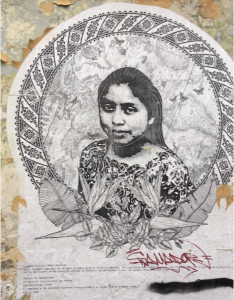 Utilizo el concepto de estructuras de violencia encarnadas de género como marco analítico para ilustrar cómo en las zonas rurales de Huehuetenango, Guatemala, las estructuras y procesos históricos y contemporáneos de violencia que centran la normalización de múltiples formas de violencia física y sexual implícita o real contra las mujeres (y a menudo otros hombres y niños) continúan socavando los esfuerzos para fortalecer los derechos de las mujeres y brindar acceso a la seguridad y la justicia para las mujeres. La superposición de estructuras de poder principalmente masculino sugiere la dificultad de separar a los actores estatales y no estatales de los vectores de violencia que afectan a las mujeres. Este artículo contribuye a la literatura emergente sobre el acceso de las mujeres indígenas a la justicia en América Latina agregando una lente transnacional a esta discusión y sugiriendo por qué no podemos separar lo público de lo privado.violencia y estado de actores no estatales.
Utilizo el concepto de estructuras de violencia encarnadas de género como marco analítico para ilustrar cómo en las zonas rurales de Huehuetenango, Guatemala, las estructuras y procesos históricos y contemporáneos de violencia que centran la normalización de múltiples formas de violencia física y sexual implícita o real contra las mujeres (y a menudo otros hombres y niños) continúan socavando los esfuerzos para fortalecer los derechos de las mujeres y brindar acceso a la seguridad y la justicia para las mujeres. La superposición de estructuras de poder principalmente masculino sugiere la dificultad de separar a los actores estatales y no estatales de los vectores de violencia que afectan a las mujeres. Este artículo contribuye a la literatura emergente sobre el acceso de las mujeres indígenas a la justicia en América Latina agregando una lente transnacional a esta discusión y sugiriendo por qué no podemos separar lo público de lo privado.violencia y estado de actores no estatales.
ARTÍCULO ACADÉMICO: Bearing Witness: Testimony in Latin American Anthropology and Related Fields. Journal of Latin American and Caribbean Anthropology
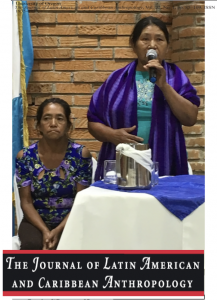 El testimonio oral es un vehículo importante para ampliar el análisis antropológico: se abre y amplía quien legítimamente habla y se escucha en una sociedad. El testimonio es también un componente crucial en la producción ´on de saberes y en la construcción ´del archivo histórico. En este artículo se refleja en el testimonio en relación con puntos que se tejen juntos como el testimonio sirve para construir nuevos conocimientos y modelos analíticos: testimonio y sus roles en la alfabetización indígena a través del tiempo; la trayectoria del testimonio de la narrativa heroica individuo a narrativas de colaboración/ colectivos; el genero, el testimonio y la resistencia a la lógica del sistema de generó colonial / moderno; y el poder del testimonio de influir en la percepción de la historia y los acontecimientos; la antropología y la movilización de testimonio en el testimonio de expertos. [Centro América, derechos humanos, genero, Mexico,
El testimonio oral es un vehículo importante para ampliar el análisis antropológico: se abre y amplía quien legítimamente habla y se escucha en una sociedad. El testimonio es también un componente crucial en la producción ´on de saberes y en la construcción ´del archivo histórico. En este artículo se refleja en el testimonio en relación con puntos que se tejen juntos como el testimonio sirve para construir nuevos conocimientos y modelos analíticos: testimonio y sus roles en la alfabetización indígena a través del tiempo; la trayectoria del testimonio de la narrativa heroica individuo a narrativas de colaboración/ colectivos; el genero, el testimonio y la resistencia a la lógica del sistema de generó colonial / moderno; y el poder del testimonio de influir en la percepción de la historia y los acontecimientos; la antropología y la movilización de testimonio en el testimonio de expertos. [Centro América, derechos humanos, genero, Mexico,
migración]
ARTÍCULO ACADÉMICO: GENDERED VIOLENCE AND INDIGENOUS MEXICAN ASYLUM SEEKERS: EXPERT WITNESSING AS ETHNOGRAPHIC ENGAGEMENT
Las contribuciones interrelacionadas de este artículo son: 1) Cómo interpretar las vidas de mujeres indígenas que buscan asilo, en relación a la vulnerabilidad estructural que existe en el oeste de Oaxaca, México, y en el proceso de solicitud de asilo en los Estados Unidos. 2) Por qué la participación como peritos o testigos expertos debe ser considerada una forma de relación etnográfica. Mi discusión presenta un análisis detallado de los casos de dos mujeres triquis solicitantes de asilo y sus conexiones con las estructuras estatales y económicas a nivel local, regional y global, así como con narrativas de violencia de género militarizada. Finalmente, discuto las maneras en que las etnografías, como objetos expertos, y los informes periciales, utilizan las evidencias y las narrativas a través de su marco interpretativo.
ARTÍCULO ACADÉMICO: Violencia transfronteriza de género y mujeres indígenas refugiadas de Guatemala
Este artículo examina la violencia de género estructural que sufren las mujeres y las niñas indígenas refugiadas de Guatemala. Para ello, se emplea un marco analítico interseccional transfronterizo y se utilizan las declaraciones incluidas en las solicitudes de asilo y las entrevistas realizadas a 24 mujeres y niñas indígenas, complementadas con 60 entrevistas a jueces, activistas, abogados y defensores que trabajan en y para los tribunales guatemaltecos especializados en violencia de género. La política económica integrada de Estados Unidos, México y América Central, así como las políticas militares, comerciales y de inmigración de la región, son el marco más amplio en el que ha evolucionado la violencia de género y son parte integrante de las vidas de las mujeres y las niñas indígenas que huyen hoy de Guatemala.
ARTÍCULO ACADÉMICO: Guatemalan Immigration to Oregon: Indigenous Transborder Communities
Este artículo cuenta la historia de la migración y asentamiento de Guatemala en Oregón a través de los indígenas Mames que han hecho el viaje principalmente durante los últimos quince años. Comprender por qué los guatemaltecos tuvieron que huir de su país y construir nuevas comunidades en Oregón requiere comprender la historia de la guerra civil guatemalteca y sus secuelas, desde 1980 hasta el presente. Hay migrantes indígenas en Oregon provenientes de varios partes de Guatemala. Me concentro aquí en el municipio de Todos Santos Cuchamatán, Huehuetenango, ofreciéndolo como un estudio de caso utilizando las historias de personas de Todos Santos para construir la historia de la migración indígena guatemalteca a Oregón. El artículo usa el concepto de comunidades transfronterizas para explicar cómo la migración ocurre a través del tiempo y resulta en redes y conexiones entre Oregon y Guatemala. Las narrativas incluidas aquí han sido creadas como parte de un proyecto de investigación en colaboración con indígenas guatemaltecos que buscan diferentes tipos de asilo en los Estados Unidos.
ARTÍCULO ACADÉMICO: The Rights to Speak and to be Heard: Women’s Interpretations of Rights Discourses in the Oaxaca Social Movement
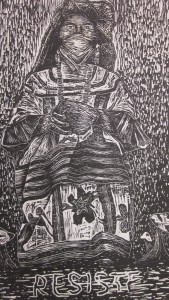 This chapter highlights the process by which several hundred women in Oaxaca City, Mexico, from different types of backgrounds took over state and then commercial media for a period of several months and in the process came to a gendered analysis of human rights. Their thinking centered on what they called the rights “to speak,” “to be heard,” and “to decide who governs.” Through an event-centered analysis I will argue that the appropriation of human rights discourses became gendered through the process of the media takeover. Through their experience running state television and radio stations and subsequently commercial stations, women who held the stations produced a gendered local vernacular of rights talk that then became accessible to many other women and men in the city. Women who were previously silenced and characterize themselves as “short, fat, and brown and the face of Oaxaca” allowed new voices to be heard, new faces to be seen, and permitted silenced models of governance and democratic participation to move into the cultural and political mainstream.
This chapter highlights the process by which several hundred women in Oaxaca City, Mexico, from different types of backgrounds took over state and then commercial media for a period of several months and in the process came to a gendered analysis of human rights. Their thinking centered on what they called the rights “to speak,” “to be heard,” and “to decide who governs.” Through an event-centered analysis I will argue that the appropriation of human rights discourses became gendered through the process of the media takeover. Through their experience running state television and radio stations and subsequently commercial stations, women who held the stations produced a gendered local vernacular of rights talk that then became accessible to many other women and men in the city. Women who were previously silenced and characterize themselves as “short, fat, and brown and the face of Oaxaca” allowed new voices to be heard, new faces to be seen, and permitted silenced models of governance and democratic participation to move into the cultural and political mainstream.
ARTÍCULO ACADÉMICO: GENDERED TRANSBORDER VIOLENCE IN THE EXPANDED UNITED STATES-MÉXICO BORDERLANDS
The domestic violence experienced by Mexican immigrant women needs to be understood within a larger context of structural violence, which includes criminal and state violence aggravated by their unprotected status in the United States as “immigrant aliens.” Transborder violence refers to forms of violence that cross multiple national, regional, class, ethnic, and state boundaries. This article uses one case of what lawyers call gender-based asylum to demonstrate how structures of transborder violence entrap women. This case represents the kinds of cases I have worked with as an expert witness. What anthropologists learn as expert witnesses provides important information about broader patterns of gendered violence that need to be documented and analyzed. This article is framed by an understanding of the borderlands, including not only the geographic United States-Mexico border but also the broader reach of transborder communities and networks, which span the United States and Mexico. In connecting the transnational drug economy, (para) militarization, domestic, and other forms of gendered violence, it illuminates the broader political, social, and economic context within which the potential and actual killing of individual women and gendered violence continues to occur.
ARTÍCULO DE DIVULGACIÓN: Género, Etnicidad y Migración: Lecciones de los Mixtecos y Zapotecos
This chapter explores how Zapotec and Mixtec patterns of migration in the western United States are gendered. A significant emphasis in this chapter is on how the experience of migration and the kind of work schedule that is demanded of low-wage migrants often rearranges gender relations in Oaxaca and in the United States alike. What happens when male farmworkers cook, sew, and clean for one another in labor camps? How do men and women work full-time in the United States, often at one or more minimum wage jobs on opposite shifts, and share childcare and domestic chores? Trans-border mothering is explored in terms of its consequences for women in Mexico and in the United States.
